We’ve all dreamed of having a lush indoor garden that’s practically maintenance-free. Water-loving plants offer the perfect solution for busy plant parents who want greenery without the guesswork of soil care. These remarkable plants thrive entirely in water and transform any space into a living oasis.
Whether you’re dealing with overwatering tendencies or simply want to try something new, aquatic plants open up endless possibilities for creative displays. From elegant glass vases filled with trailing pothos to sophisticated hydroponic setups, these plants prove that soil isn’t always necessary for stunning growth.
We’ll explore the most resilient water-dwelling plants that’ll flourish in your home with minimal effort. You’ll discover which varieties adapt best to water-only environments and learn simple techniques to keep them thriving year-round. Get ready to revolutionize your plant game with these virtually indestructible beauties.
Lucky Bamboo: The Ultimate Beginner’s Water Plant
Lucky bamboo stands out as our top recommendation for anyone starting their water plant journey. This resilient plant thrives exclusively in water, making it perfect for beginners who want guaranteed success.
Easy Care Requirements
Water management becomes effortless with lucky bamboo since it needs only distilled or filtered water changed every 1-2 weeks. We recommend keeping water levels at 1-2 inches to cover the roots completely while avoiding tap water that contains chlorine and fluoride.
Light preferences favor bright, indirect sunlight rather than direct exposure that can scorch the leaves. Placing your lucky bamboo near an east or north-facing window provides optimal growing conditions without stress.
Temperature stability works best between 65-75°F, which matches most indoor environments perfectly. We’ve found that consistent room temperature eliminates the need for special heating or cooling adjustments.
Fertilizer application requires liquid fertilizer diluted to quarter strength once monthly during growing season. Over-fertilizing causes more harm than good, so we suggest starting with less rather than more.
Feng Shui Benefits
Wealth attraction comes from placing lucky bamboo in the southeast corner of your home according to traditional feng shui principles. We often hear from readers who notice positive financial changes after positioning their plants strategically.
Positive energy flow increases throughout living spaces when lucky bamboo arrangements feature exact stalk numbers. Three stalks represent happiness, five stalks attract wealth, and six stalks promote good luck and prosperity.
Stress reduction occurs naturally as the gentle presence of lucky bamboo creates calming energy in any room. We recommend placing arrangements in home offices or bedrooms where peaceful vibes enhance daily life.
Relationship harmony improves when couples share care responsibilities for their lucky bamboo plants. The practice of nurturing something together strengthens bonds while bringing positive energy into shared spaces.
Pothos: The Trailing Water Wonder
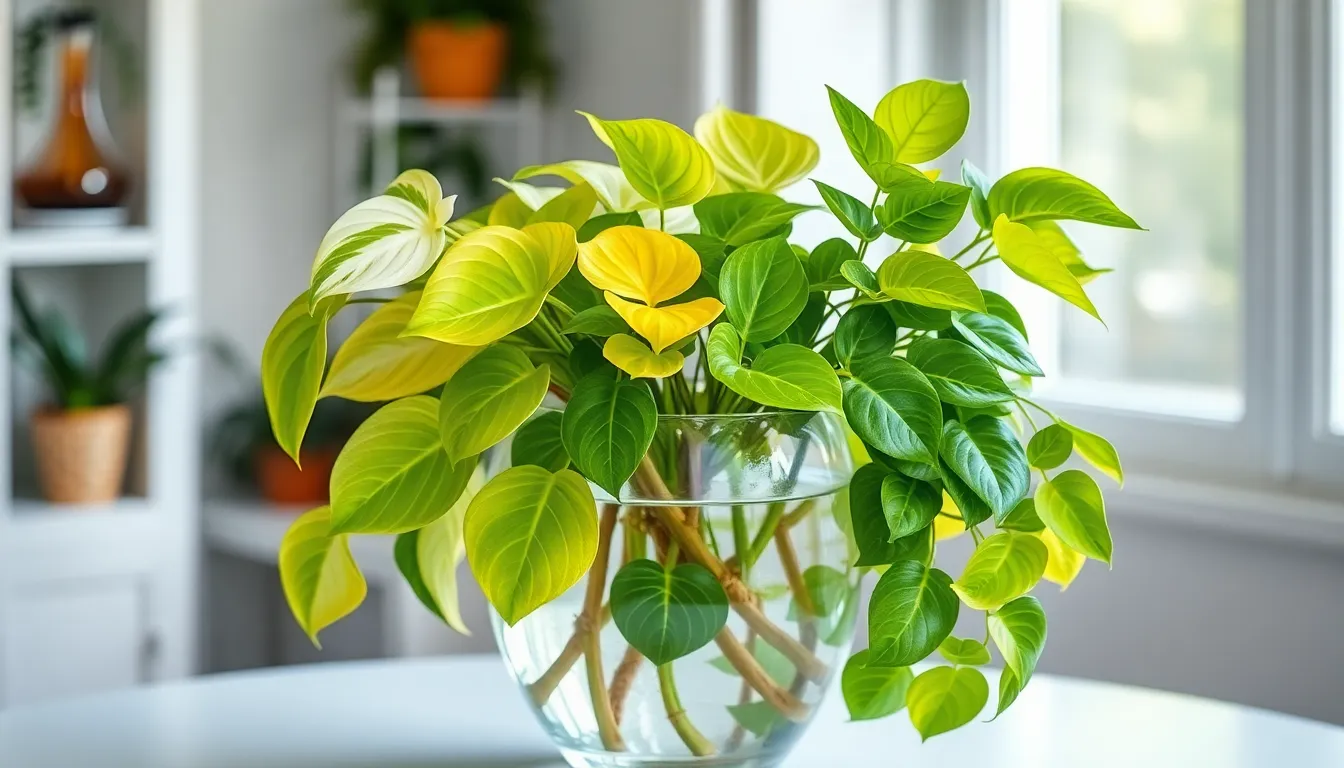
Pothos stands out as one of our favorite water-loving plants, earning its reputation as the perfect trailing companion for any water garden. This resilient vine with heart-shaped leaves transforms any space with its cascading growth pattern while thriving in simple water setups.
Different Varieties for Water Growing
Golden Pothos leads our list of water-friendly varieties, featuring vibrant yellow and green variegated leaves that brighten any room. This classic variety develops robust root systems quickly when placed in water containers.
Marble Queen Pothos offers stunning white and green variegation that creates an elegant waterfall effect as it trails. We’ve found this variety particularly responsive to water propagation, often showing new growth within weeks.
Neon Pothos brings electric lime-green foliage that practically glows in water displays. This variety maintains its vibrant color even in lower light conditions, making it ideal for indoor water gardens.
Jade Pothos provides solid green leaves with a glossy finish that complements any water container. We recommend this variety for beginners since it’s the most forgiving and adapts quickly to water-only environments.
Pearls and Jade Pothos features small, compact leaves with cream and green patterns that create delicate trailing displays. This newer variety excels in water propagation and maintains its compact growth habit.
Propagation Tips
Select healthy stem cuttings with at least one node visible, as this is where new roots will emerge in water. We always choose cuttings that are 4-6 inches long with several leaves attached.
Change water every 7-10 days to prevent bacterial buildup and maintain oxygen levels for healthy root development. Fresh water keeps our pothos cuttings thriving and prevents that murky appearance.
Position containers in bright, indirect light away from direct sunbeams that can overheat the water and damage developing roots. We’ve seen the best results with north or east-facing windows.
Maintain water temperatures between 65°F to 75°F for optimal root growth and overall plant health. Room temperature water works perfectly for most indoor environments.
Add liquid fertilizer monthly at quarter strength to boost growth once roots establish after 2-3 weeks. We dilute standard houseplant fertilizer to avoid burning the delicate water roots.
Use clear glass containers so we can monitor root development and detect any issues early. Mason jars, vases, or recycled glass bottles work beautifully for pothos water gardens.
Peace Lily: Elegant Blooms in Water
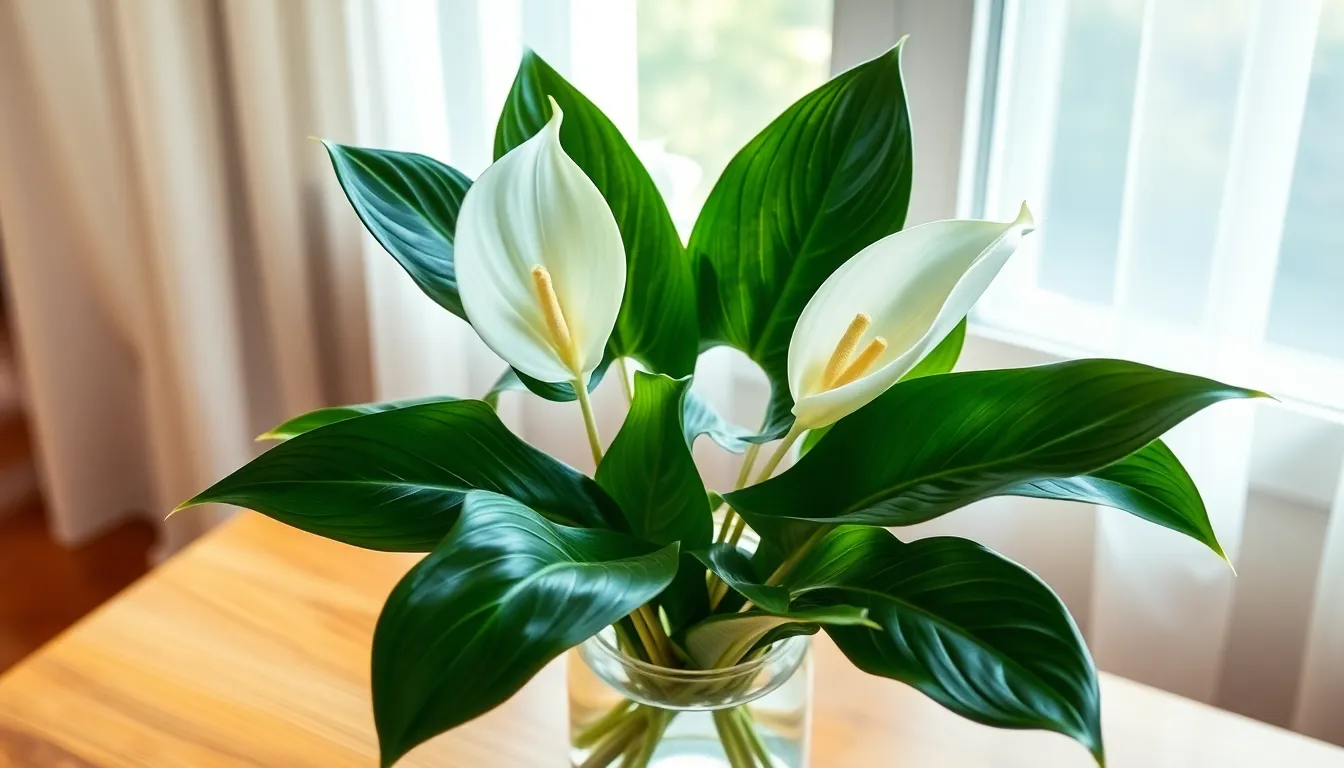
Peace lilies bring sophisticated beauty to water gardens with their glossy dark green leaves and striking white blooms. These tropical plants adapt remarkably well to hydroponic growing conditions when we provide proper care and attention.
Flowering Requirements
Peace lilies produce their signature white flowers when we provide moderate indirect light and maintain consistent moisture levels. Brighter indirect light encourages more frequent blooms and extends their flowering duration significantly. Direct sunlight can scorch the delicate leaves and damage the plant’s overall health.
We should position our peace lilies in locations that receive gentle, filtered light throughout the day. Consistent moisture levels stimulate flowering better than sporadic watering patterns. Low light conditions are tolerable for these resilient plants, but they won’t bloom as prolifically without adequate illumination.
Water Quality Needs
Fresh water changes are essential for preventing stagnation and maintaining healthy root systems in our peace lilies. We need to replace the water regularly to ensure proper oxygenation and prevent fungal diseases from developing.
Water Temperature Requirements:
- Lukewarm or room temperature water works best for optimal growth
- Cold water can shock the plant and cause unsightly leaf browning
- Consistent temperatures prevent stress and promote steady development
Maintenance Schedule:
- Change water every 1-2 weeks to prevent bacterial buildup
- Monitor roots weekly for signs of rot or deterioration
- Rinse roots gently during water changes to remove debris
We must avoid letting our peace lilies sit in stagnant water for extended periods. Regular water changes combined with proper lighting create the ideal conditions for these elegant plants to thrive and produce their stunning white blooms consistently.
Spider Plant: Air-Purifying Water Companion
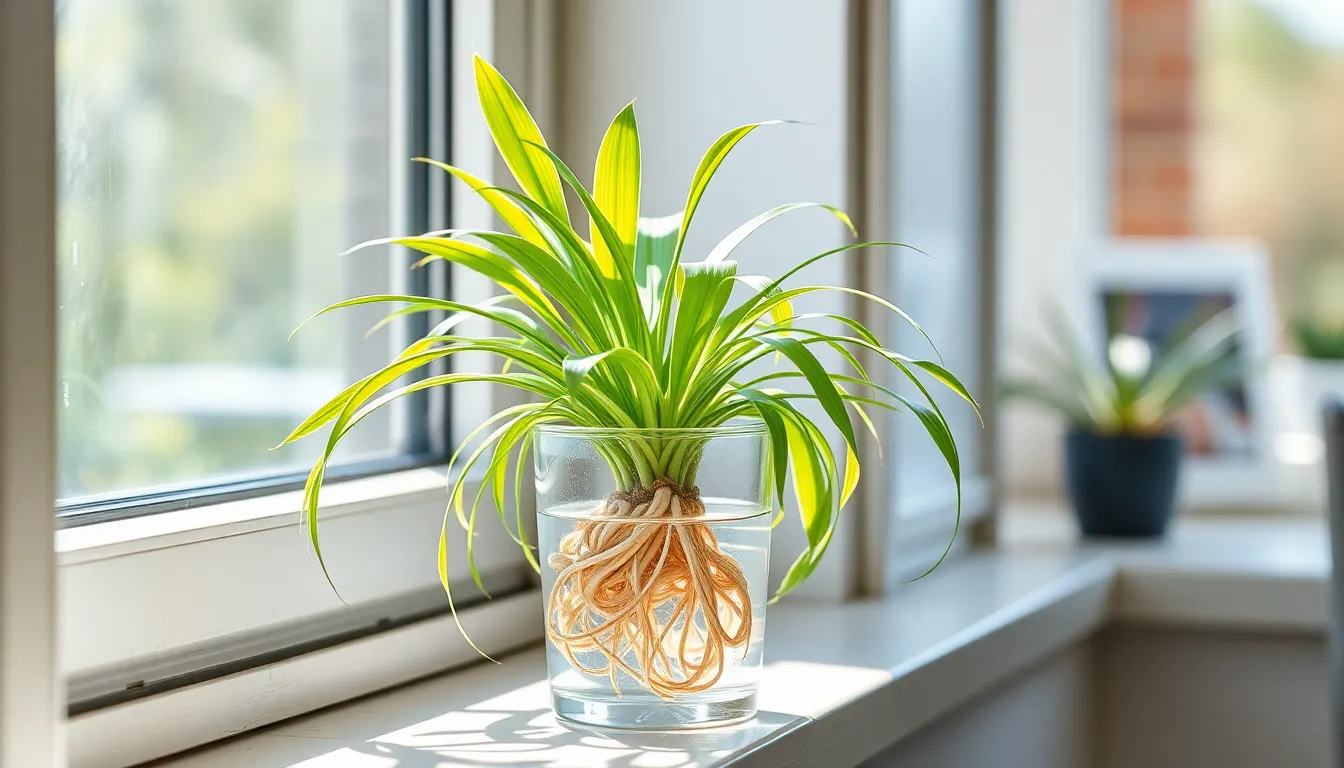
Spider plants (Chlorophytum comosum) excel as water companions while naturally purifying indoor air. We’ve discovered these versatile plants adapt beautifully to water environments even though not being true aquatic species.
Root Development in Water
Placing spider plants in water triggers fascinating root development from their baby plantlets or runners. White and fine roots emerge within days, specifically adapting to absorb nutrients directly from their liquid environment. Water changes become essential every few days to prevent stagnation and protect against root rot that can quickly destroy the plant.
Clean water maintains optimal growing conditions for these delicate root systems. Indirect light supports healthy development without overwhelming the tender new growth. Regular monitoring ensures roots remain white and healthy rather than turning brown or mushy from bacterial issues.
Fresh water every 3-4 days keeps the root zone oxygenated and nutrient rich. Temperature consistency around 65-75°F promotes steady growth patterns. Adequate lighting from nearby windows or grow lights encourages robust root formation.
Baby Plantlet Care
Spider plants reproduce through charming offshoots called baby plantlets that dangle from the mother plant like tiny green spiders. Removing these plantlets requires gentle cutting at their connection point to the runner stem. Water containers should hold each plantlet with its developing nodes submerged while leaves stay above the surface.
Several inches of root growth typically takes 2-3 weeks in optimal conditions. Monitoring becomes crucial during this vulnerable stage when fungal growth or decay can quickly set in. Fresh water every few days prevents bacterial buildup that threatens young root systems.
Transplanting options open up once roots reach 2-3 inches in length, allowing continued water growth or soil transition. Baby plantlets thrive with consistent care and proper water refreshment schedules. Root health indicators include white coloration and firm texture throughout the development process.
Philodendron: Heart-Shaped Leaves in Hydroponic Setup
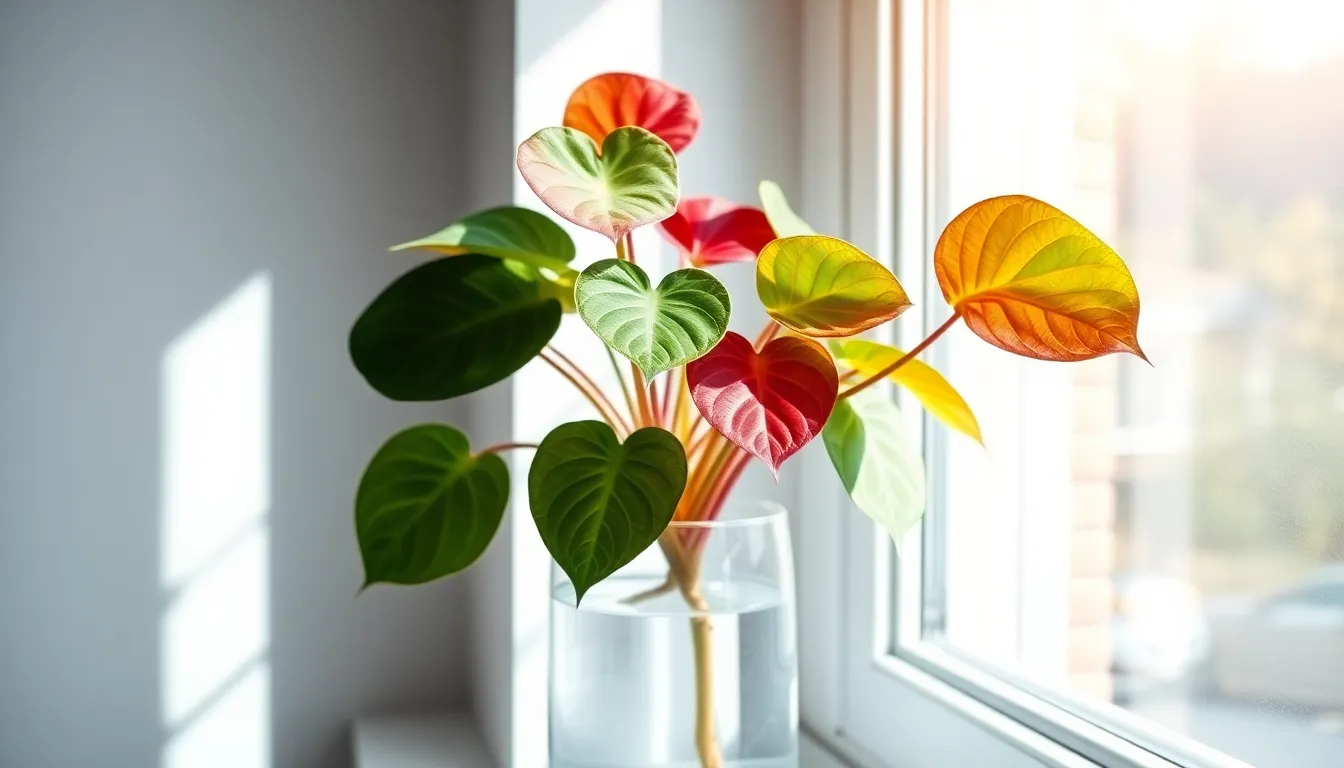
Philodendrons bring distinctive heart-shaped foliage to our water gardens, adapting beautifully to hydroponic environments where their roots thrive in nutrient-rich water answers. We’ll explore how these beloved houseplants flourish without soil, making them perfect additions to our aquatic plant collections.
Popular Water-Growing Varieties
Classic philodendrons like heartleaf varieties excel in hydroponic setups, developing robust root systems that absorb nutrients directly from water. Their glossy, heart-shaped leaves create stunning visual displays in glass containers or aquarium environments.
Trailing philodendrons produce cascading vines that look particularly striking when grown in tall water vessels, allowing their stems to drape gracefully over container edges. These varieties develop aerial roots along their stems, which readily adapt to submerged conditions.
Compact varieties work exceptionally well for desktop water gardens, maintaining manageable sizes while producing the same characteristic heart-shaped foliage. We find these smaller cultivars perfect for office spaces or kitchen windowsills where larger plants might overwhelm the area.
Light Requirements
Bright, indirect light serves as the optimal condition for philodendrons in hydroponic systems, promoting healthy leaf development without causing burn damage. We position our water-grown philodendrons near east or north-facing windows where they receive consistent illumination throughout the day.
Direct sunlight exposure can scorch philodendron leaves, creating brown patches that diminish their ornamental value and stress the plant’s overall health. Filtered light through sheer curtains or placement several feet from sunny windows prevents this damage while maintaining adequate brightness.
Low light conditions significantly slow philodendron growth rates, causing leaves to lose their vibrant coloration and become smaller over time. We’ve observed that insufficient lighting also weakens their root development in water environments, making regular water changes even more critical for plant health.
Supplemental grow lights can enhance philodendron performance in darker spaces, providing the consistent illumination needed for robust growth in hydroponic setups. LED plant lights positioned 12-18 inches above the foliage deliver effective results without generating excessive heat that could warm the water.
Coleus: Colorful Foliage for Water Gardens
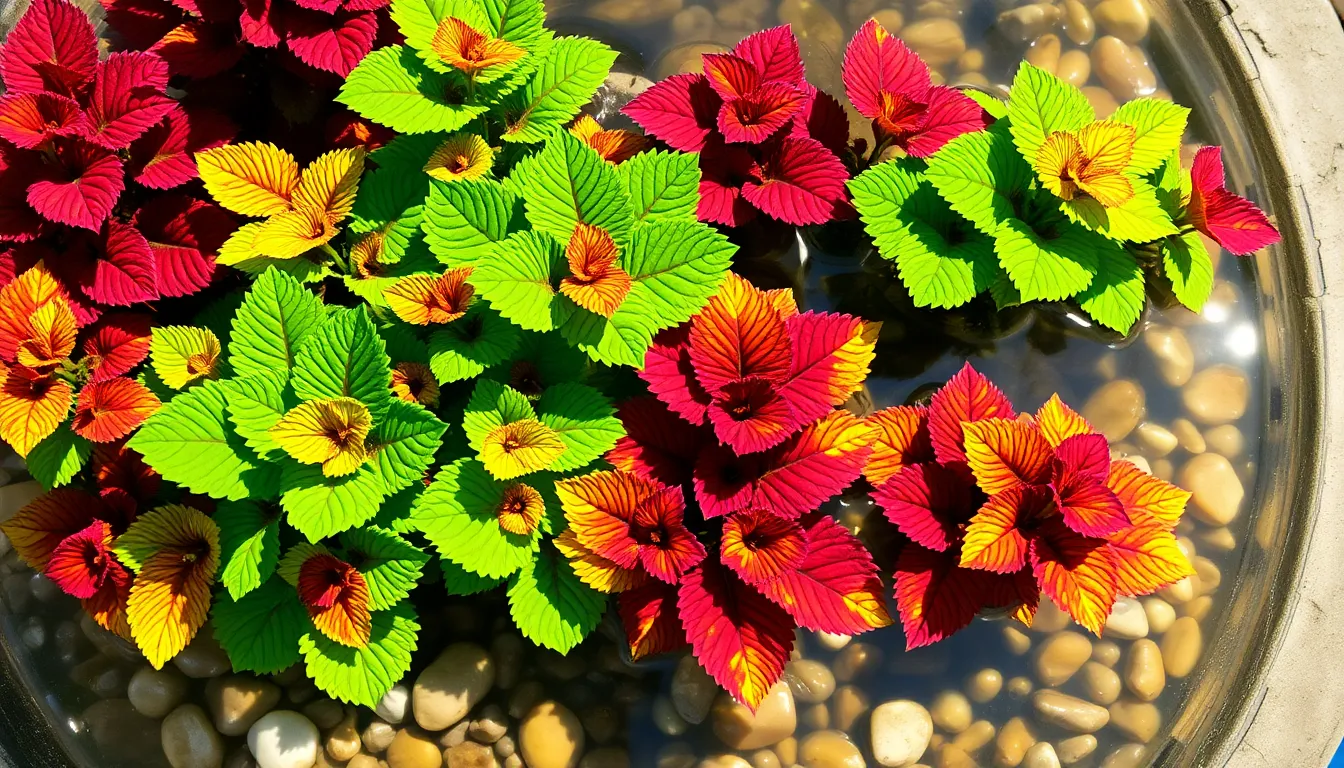
Coleus brings stunning multicolored leaves to water gardens through its unique ability to thrive in aquatic environments. This traditionally terrestrial plant adapts beautifully to water-based growing systems when propagated correctly.
Stem Cutting Propagation
Starting coleus in water begins with selecting healthy stem cuttings from established plants. We recommend choosing vigorous stems that show vibrant coloration and no signs of disease or pest damage.
Cutting preparation requires removing lower leaves while keeping 4-6 leaves at the top of each stem. This prevents underwater leaves from rotting and directs the plant’s energy toward root development.
Placing cuttings in clean water initiates the rooting process within 7-14 days. Room temperature filtered or distilled water works best for encouraging healthy root growth without chemical interference.
Monitoring water levels ensures cuttings remain properly submerged during the rooting phase. We change the water every 3-4 days to prevent bacterial buildup and maintain oxygen levels.
Roots typically develop into a substantial network within 2-3 weeks of initial placement. Once roots reach 2-3 inches in length, coleus can continue thriving permanently in water or be transplanted to soil.
Maintaining Vibrant Colors
Bright indirect light preserves coleus’s signature colorful foliage throughout the growing season. Direct sunlight can fade the intense reds, purples, and yellows that make coleus so attractive in water gardens.
Nutrient rich water supports the vivid coloration that coleus is known for displaying. Since water-grown plants rely entirely on dissolved nutrients, we add liquid fertilizer every 2-3 weeks during active growing periods.
Temperature stability between 65-75°F maintains optimal color intensity and plant health. Fluctuating temperatures can cause color dulling and stress that affects overall plant vitality.
Regular water changes every 5-7 days prevent nutrient depletion and maintain plant vigor. Fresh water ensures coleus receives consistent nutrition while preventing algae growth that competes for nutrients.
Supplemental grow lights enhance coloration during winter months or in low light conditions. LED grow lights positioned 12-18 inches above plants provide the necessary light spectrum for maintaining brilliant foliage colors year-round.
English Ivy: Cascading Beauty in Water Containers
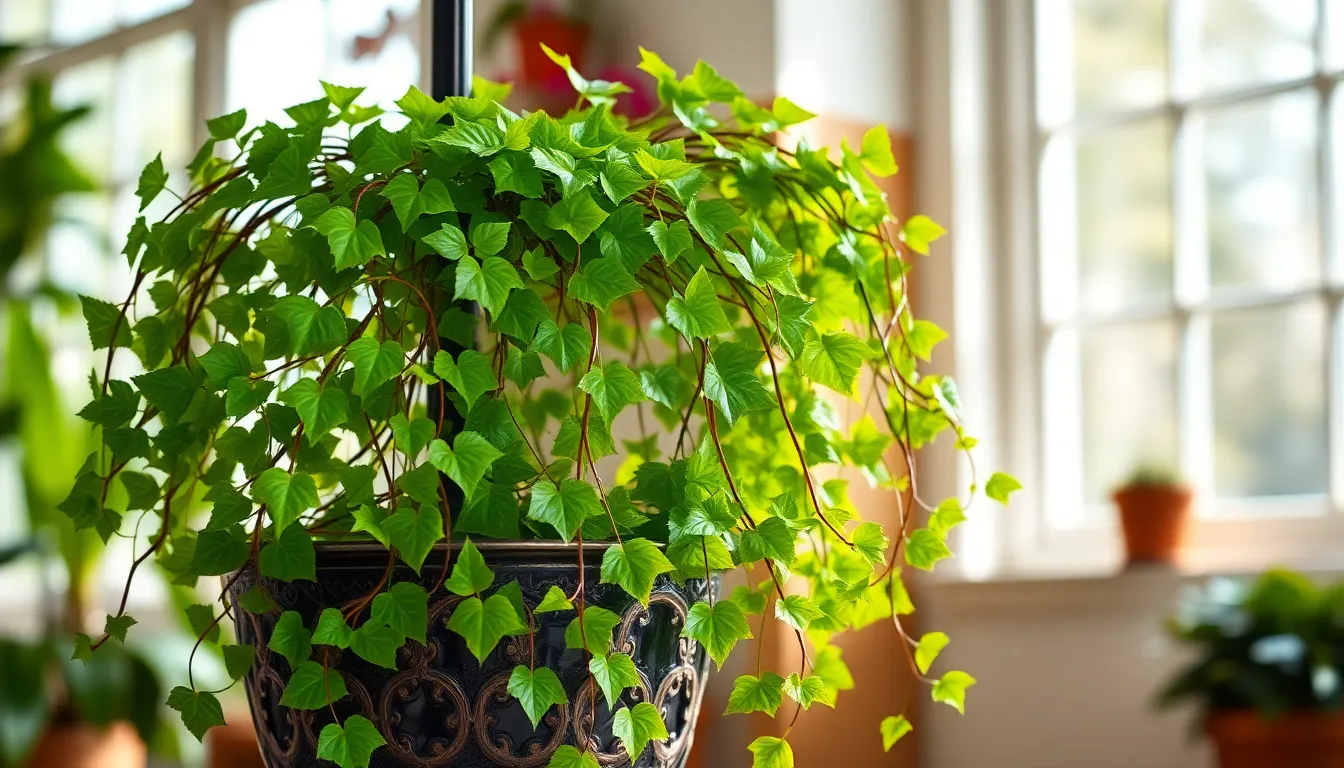
English Ivy transforms into a stunning decorative element when grown in water containers, creating lush trailing displays that enhance any indoor space. Unlike true aquatic plants, this adaptable vine temporarily thrives in water while producing those coveted cascading effects we all love.
Training Growth Patterns
English Ivy’s growth pattern responds beautifully to training when grown in water containers. We can guide the trailing vines along decorative supports like trellises, wire frames, or even simple bamboo stakes to create exact shapes and forms. The vines naturally cascade downward, making them perfect for hanging planters or elevated containers where the trailing effect becomes a focal point.
Training works best when we gently wrap new growth around our chosen supports while the stems remain flexible. We’ll find that regular positioning of the vines every few weeks helps maintain our desired shape as the plant continues growing. The cascading nature becomes more pronounced over time, creating that lush, waterfall effect that makes English Ivy so appealing in water culture.
Pest Prevention
Pest prevention in water grown English Ivy requires different strategies than soil based plants since traditional soil pests won’t be an issue. We need to focus on maintaining clean water conditions to prevent algae growth, which can compete with our ivy for nutrients and create unsightly green films on container surfaces.
Stagnation poses the biggest threat to healthy water culture, so we should change the water completely every 7 to 10 days. Fresh water prevents bacterial buildup and reduces the likelihood of fungal issues that can affect the roots and lower stems.
Natural pest deterrents work well in water culture since we can add them directly to the water supply. A few drops of neem oil or diluted hydrogen peroxide can help prevent fungal growth without harming the plant. We can also add activated charcoal pieces to the water to naturally filter impurities and maintain cleaner growing conditions.
Monitoring for signs of root rot becomes crucial since overwatered roots in stagnant conditions can quickly deteriorate. Healthy roots should appear white or light colored, while brown or mushy roots indicate problems that require immediate water changes and root trimming.
Chinese Evergreen: Low-Light Water Plant
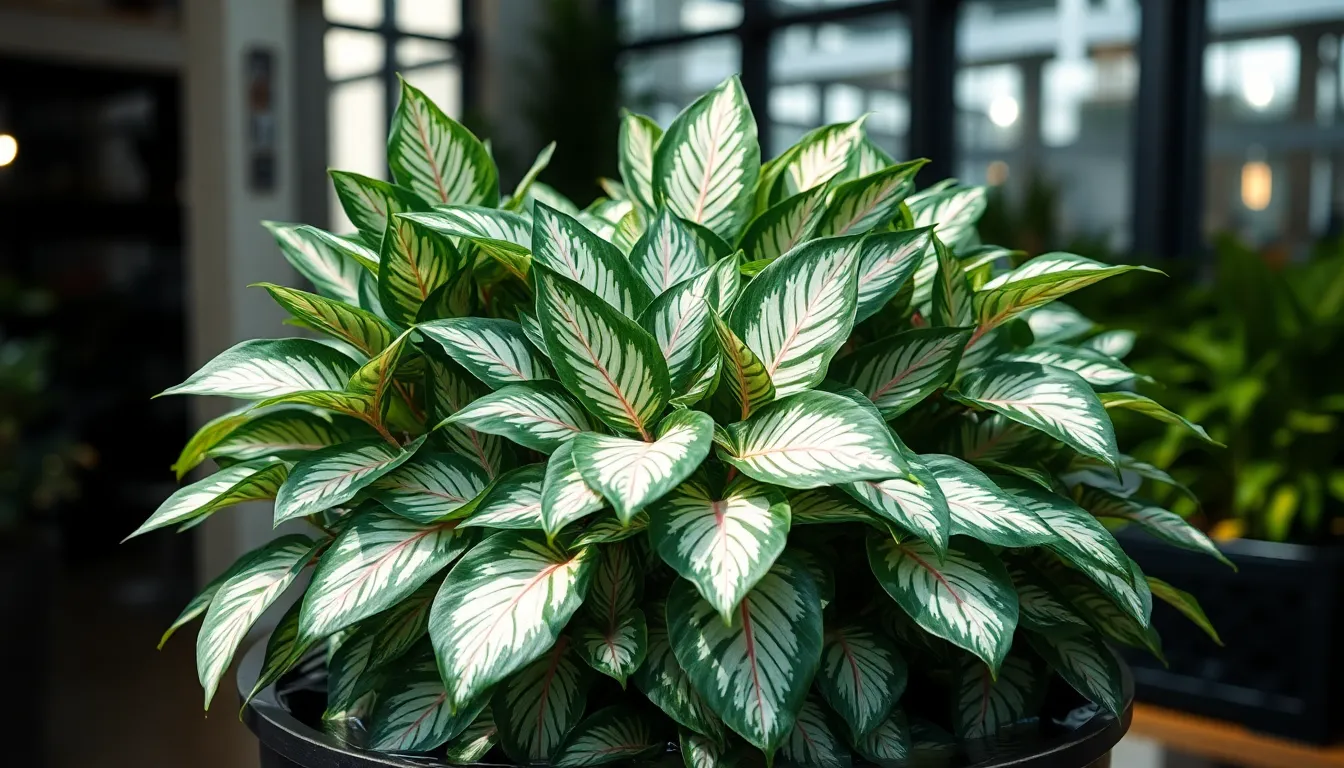
Chinese Evergreen offers a unique approach to water gardening, thriving in consistently moist conditions while adapting beautifully to low light environments. We’ve discovered this versatile plant creates stunning displays when grown in hydroponic setups with proper humidity management.
Leaf Pattern Variations
Diverse varieties of Chinese Evergreen showcase remarkable leaf patterns that range from solid green to beautifully variegated designs. Silver, white, and pink markings create striking visual interest across different cultivars, making each plant a unique decorative element for your water garden.
Darker green varieties perform exceptionally well in dimmer conditions, requiring minimal light to maintain their lush appearance. Variegated types need brighter indirect light to preserve their distinctive patterns and vibrant colors throughout the growing season.
Light exposure directly influences the intensity of variegation in Chinese Evergreen plants grown in water. Brighter indirect light enhances leaf patterns significantly, while lower light conditions may cause variegated markings to fade or become less pronounced over time.
Temperature Considerations
Temperature stability above 60°F proves crucial for Chinese Evergreen success in water environments, with consistent warmth promoting healthy root development. We recommend maintaining temperatures between 65°F and 75°F for optimal growth and leaf pattern retention.
Cold temperatures below 60°F can cause severe damage to Chinese Evergreen plants, leading to leaf drop and stunted growth in hydroponic systems. Stable room temperatures prevent temperature shock that often occurs when plants experience sudden environmental changes.
Warm conditions combined with proper humidity levels create the ideal environment for Chinese Evergreen water cultivation. Temperature fluctuations should be minimized to maintain plant health, especially during winter months when heating systems can create inconsistent growing conditions.
Water Hyacinth: Floating Aquatic Beauty
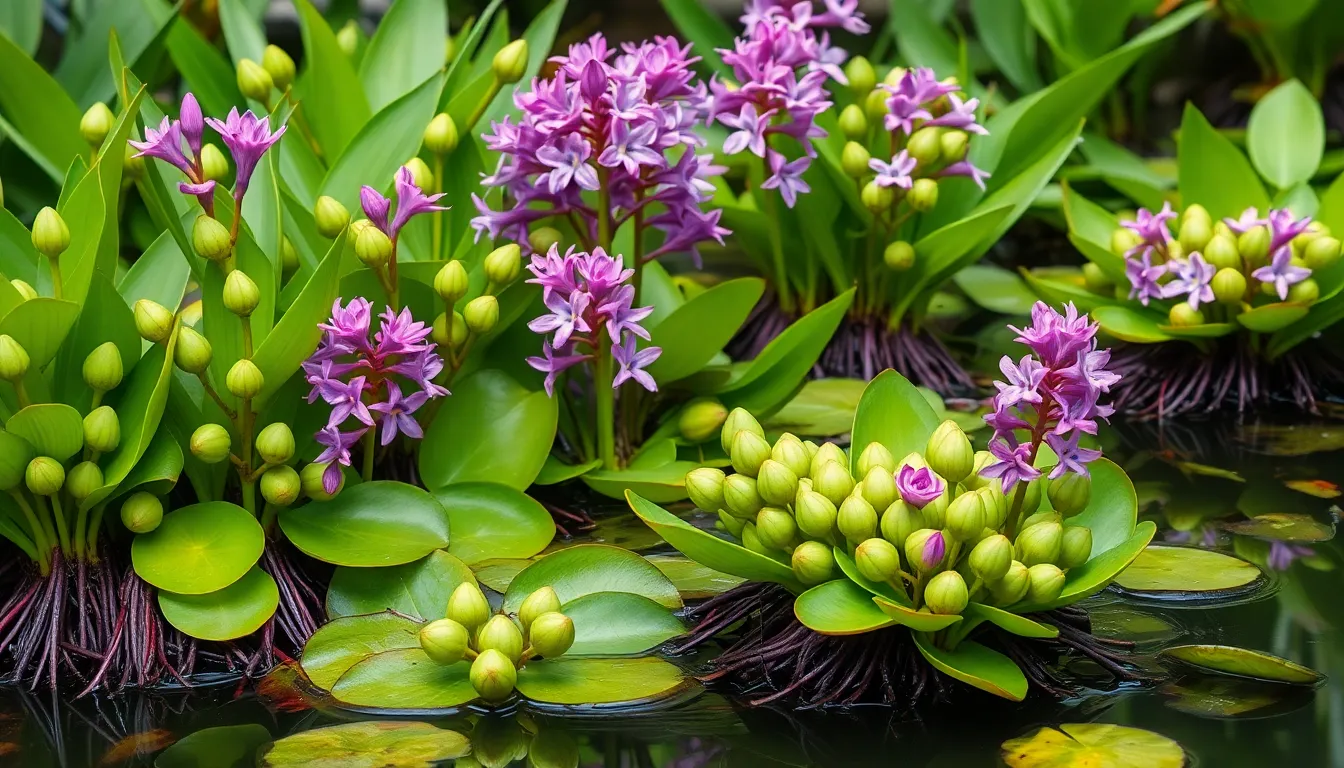
Water hyacinth stands out as one of nature’s most spectacular floating plants, creating stunning displays with its violet to pink flowers and distinctive bulbous stalks. We’ve discovered that this free-floating aquatic perennial transforms outdoor water gardens into breathtaking landscapes.
Outdoor Water Garden Use
Aesthetic appeal drives most gardeners to include water hyacinth in their outdoor water features. The plant produces spike-like floral stalks approximately 1 foot tall, bearing clusters of 10 light violet to pink flowers that create striking visual impact. Each flower displays six petals, with the top petal marked by a bright yellow spot surrounded by a bluish halo.
Floating characteristics make water hyacinth particularly valuable for water garden design. Thick, waxy, oval-shaped leaves about 12–15 cm wide arrange themselves in attractive clusters or rosettes on the water surface. Below the waterline, dark purple or black feathery roots hang freely, adding underwater visual interest while the swollen, bulb-like stalks filled with air pockets provide natural buoyancy.
Dense mat formation occurs as water hyacinth spreads via horizontal stems called stolons, creating interconnected rafts that can cover large water surfaces. These natural groupings provide excellent coverage for ornamental ponds and larger water features, though they require careful monitoring to prevent overcrowding.
Growth Control Methods
Mechanical removal serves as the primary control method for managing water hyacinth populations in outdoor water gardens. We recommend regular thinning to prevent overcrowding and maintain balanced network conditions. Physical harvesting works best when plants are young and manageable, before they form extensive mat systems.
Biological control agents offer environmentally friendly management options for larger water features. Certain weevils and moths naturally feed on water hyacinth, helping control population growth without chemical intervention. These natural predators work effectively in established outdoor environments where chemical treatments might harm other aquatic life.
Chemical herbicides provide targeted control where appropriate and permitted by local regulations. Professional application ensures proper dosage and timing while minimizing environmental impact. Always check local guidelines before using any chemical treatments in water gardens or natural water bodies.
Regular monitoring prevents water hyacinth from overwhelming outdoor water systems. Weekly inspections during growing season help identify rapid spread before it becomes problematic. Maintaining water flow and preventing complete surface coverage protects other aquatic plants and wildlife that depend on open water access.
Arrowhead Plant: Changing Leaf Shapes in Water
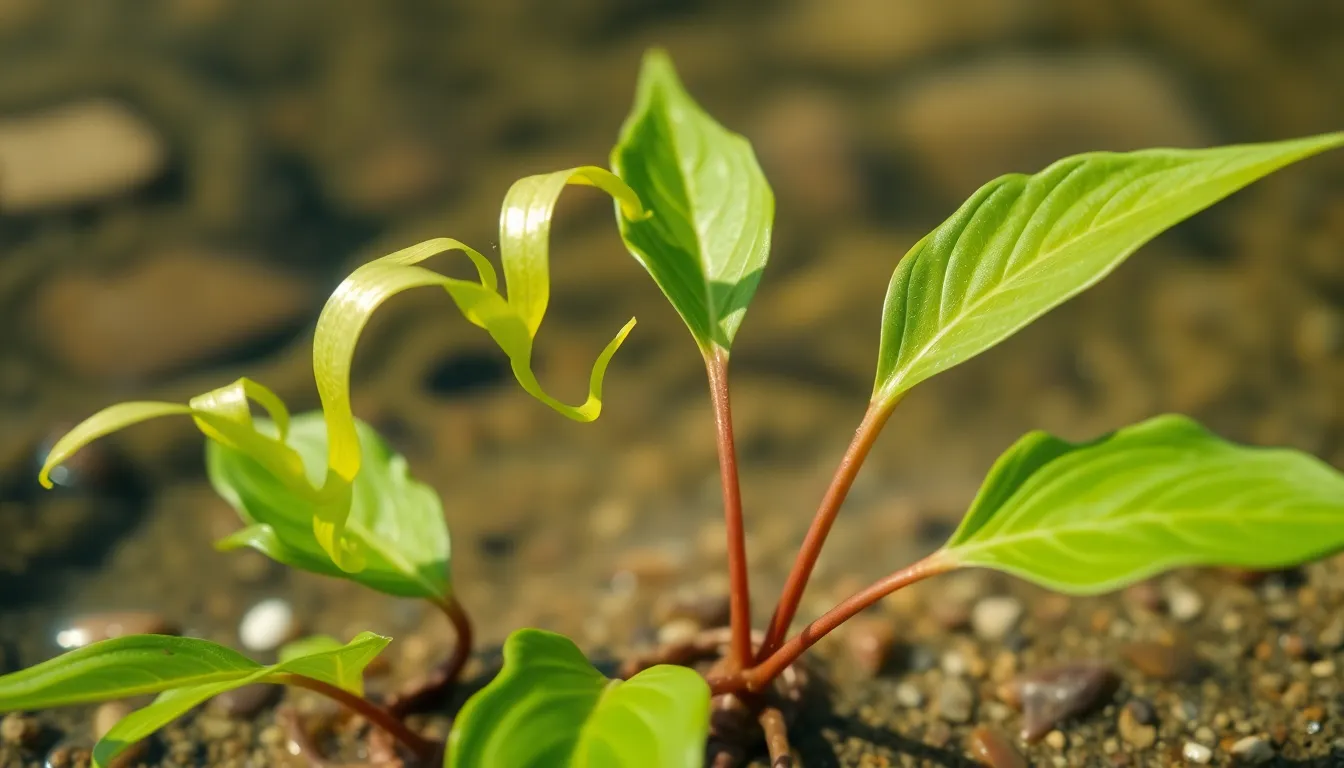
The Arrowhead Plant (Sagittaria) stands out among aquatic plants for its remarkable ability to transform its leaf structure as it adapts to different water conditions. We’ll explore how this fascinating plant demonstrates nature’s ingenuity through its changing foliage and specialized support systems.
Juvenile vs Mature Foliage
Juvenile foliage begins as narrow, ribbon-like leaves perfectly adapted for submerged growth conditions. These early leaves resemble aquatic grass blades and remain linear when the plant lives underwater or partially submerged. Water current resistance becomes minimal with this streamlined design, allowing young plants to establish themselves effectively in aquatic environments.
Mature foliage develops into the plant’s signature arrow-shaped leaves as it grows above water or reaches maturity. Broader leaf surfaces emerge that enhance photosynthesis and gas exchange when exposed to air rather than water. This transformation from linear to arrowhead-shaped foliage represents a perfect example of heterophylly, where one plant produces completely different leaf forms based on environmental conditions.
Enhanced photosynthesis occurs through these mature aerial leaves, which become more rigid and structured compared to their flexible underwater counterparts. Gas exchange improves dramatically as the plant adapts its leaf architecture to maximize exposure to atmospheric conditions.
Support Structure Needs
Specialized stem architecture provides the Arrowhead Plant with flexible yet sturdy support systems designed for aquatic environments. Water currents require stems that can bend without breaking, allowing the plant to move naturally with flowing water while maintaining structural integrity.
Internal air spaces called aerenchyma create a sophisticated buoyancy system within the plant’s tissues. Oxygen transport becomes possible from aerial parts down to submerged roots through these specialized air channels. This internal structure helps the plant maintain proper gas exchange even when roots remain underwater in saturated soils.
Root anchoring systems secure the plant firmly in submerged or waterlogged substrates while remaining lightweight enough for aquatic conditions. These roots differ significantly from terrestrial plant roots, being smaller and designed for reduced weight underwater. Flexible stems work along with these specialized roots to allow leaves to float on the surface or rise above water levels as needed.
Buoyancy control becomes essential for the plant’s survival, with the aerenchyma system providing natural flotation that keeps vital plant parts at optimal depths for both nutrient absorption and photosynthesis.
Sweet Potato Vine: Edible Ornamental in Water
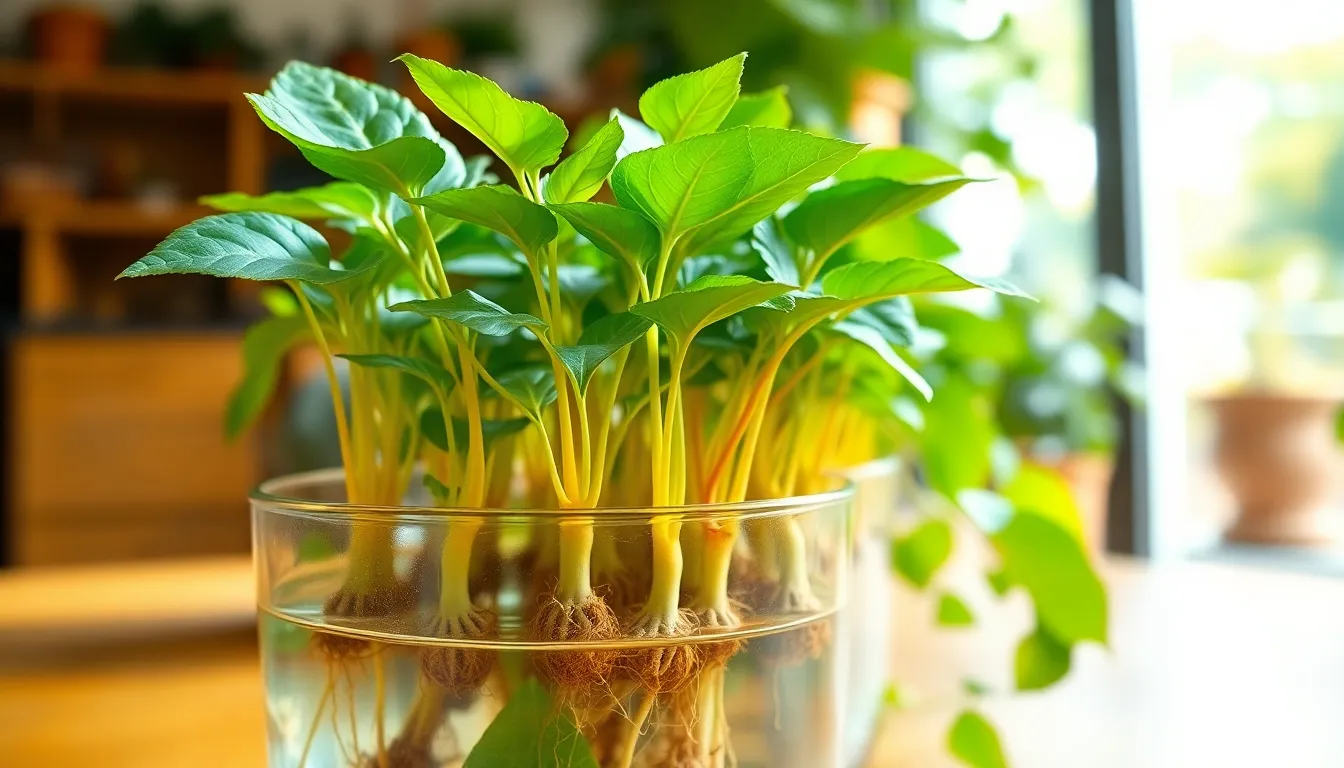
We’ve discovered that sweet potato vines offer a unique combination of beauty and functionality in water gardens. These versatile plants serve as both decorative elements and edible additions to our aquatic collection.
Rooting Process
Starting with a healthy cutting from 6 to 12 inches long creates the foundation for successful water propagation. We select cuttings that include several leaves and make our cut just below a leaf node where roots naturally emerge.
Removing the lower leaves prevents rot while keeping the water clean and oxygenated. We strip away any foliage that would sit below the waterline and preserve the upper leaves for essential photosynthesis.
Placing the prepared cutting in room temperature water begins the rooting journey. We position our container in bright, indirect light and avoid direct sunlight that could stress the developing roots.
Maintaining fresh water quality accelerates healthy root development throughout the process. We change the water every few days to prevent bacterial buildup and ensure optimal growing conditions.
Watching for root emergence typically happens within one to two weeks of initial placement. White roots appear at the former leaf node locations and signal successful propagation when they reach 2 to 3 inches in length.
Harvest Timing
Transitioning rooted cuttings to potting mix becomes possible once roots develop sufficient length and strength. We can move our sweet potato vines to soil at any point after achieving adequate root development.
Collecting new vine pieces for continuous propagation supports ongoing growth and expansion of our collection. The plant’s quick growth rate allows us to harvest slips regularly without compromising the parent plant’s health.
Timing our harvest based on root development rather than calendar dates ensures the best success rates. We monitor root length and overall plant vigor to determine the optimal moment for either transplanting or continued water growth.
Water Lettuce: Natural Water Filter Plant
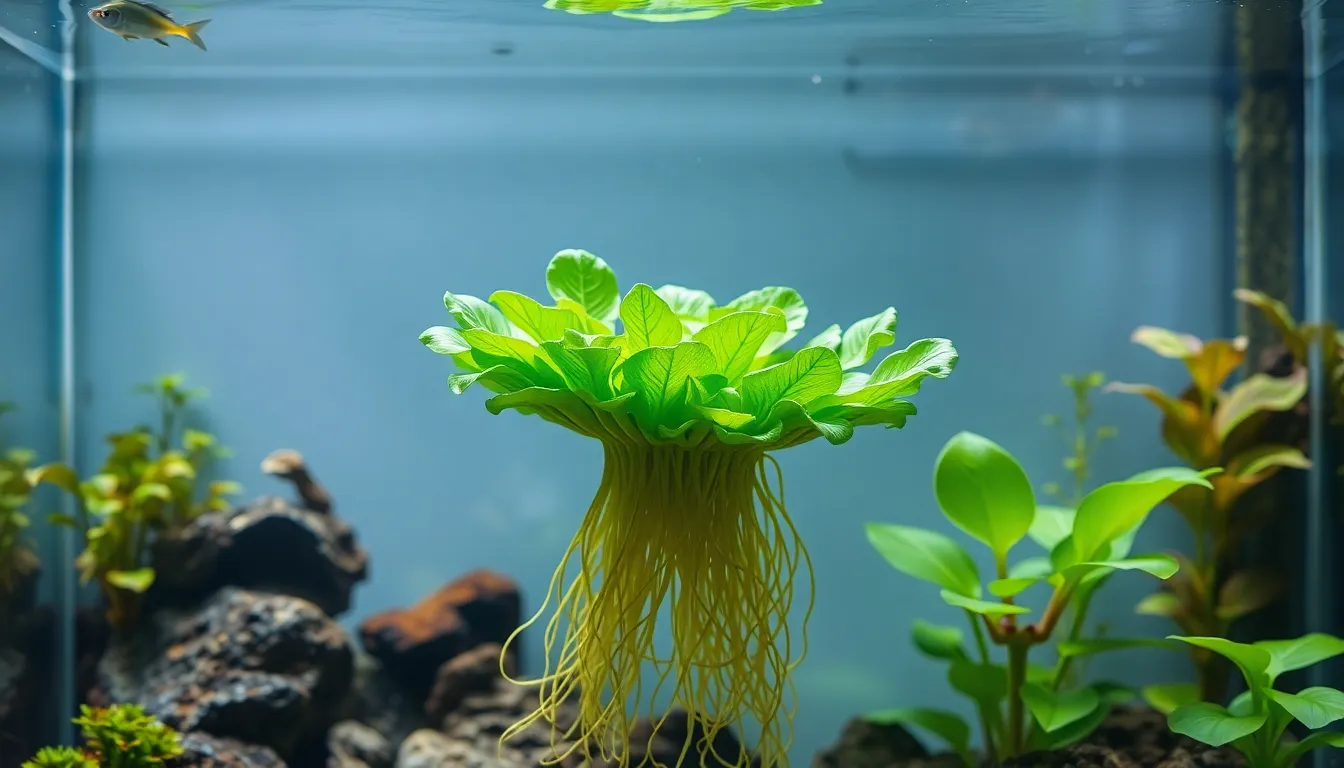
Water lettuce transforms your aquatic space into a natural filtration system while adding beautiful tropical aesthetics. We’ll explore how this floating wonder enhances both indoor and outdoor water environments.
Aquarium Compatibility
Floating design makes water lettuce perfect for freshwater aquariums and ponds since it doesn’t require soil or substrate planting. We recommend this plant for aquarists seeking natural shade and algae control in their setups.
Light management becomes crucial when using water lettuce, as dense mats can block light penetration to plants below. We suggest monitoring coverage to ensure other aquatic plants receive adequate illumination for healthy growth.
Natural filtration benefits make water lettuce an excellent choice for water gardens and aquarium systems. We’ve found it particularly effective in providing shelter for fish while maintaining water quality through its biological processes.
Nutrient Absorption Benefits
Nitrogen and phosphorus removal occurs naturally as water lettuce absorbs excess nutrients from the water column. We see important improvements in water quality when these floating plants actively process waste materials and prevent algae blooms.
Root system filtration provides extensive surface area where beneficial bacteria can colonize and break down organic matter. We observe how the feathery roots, extending 50 to 80 centimeters into the water, trap suspended particles and clarify murky conditions.
Algae growth inhibition results from water lettuce limiting sunlight penetration while competing for nutrients. We notice reduced algae problems in systems where these plants maintain proper coverage without overwhelming the entire water surface.
Microbial support develops around the dense root structures, creating beneficial bacterial colonies that enhance biological filtration. We recommend regular monitoring to ensure water lettuce doesn’t form overly thick mats that could disrupt oxygen levels or fish communities.
Conclusion
Growing plants in water opens up a industry of possibilities for both indoor and outdoor gardening enthusiasts. We’ve explored how these resilient aquatic beauties can transform your living spaces while requiring minimal maintenance compared to traditional soil-based plants.
Whether you’re drawn to the elegant simplicity of lucky bamboo or the vibrant foliage of coleus these water-loving plants offer something for every skill level and aesthetic preference. From air-purifying spider plants to natural filtration systems like water lettuce each variety brings unique benefits to your home or garden.
The versatility of water gardening means you can start small with a single cutting on your windowsill and gradually expand to create stunning outdoor water features. With proper care and attention to water quality these plants will reward you with lush growth and natural beauty year-round.
Frequently Asked Questions
What are the best water-loving plants for beginners?
Lucky bamboo is the ultimate beginner’s water plant due to its incredible resilience and minimal care requirements. Other excellent options include pothos with its heart-shaped trailing leaves, spider plants for their air-purifying qualities, and philodendrons for their adaptability. These plants thrive in water-only environments and are perfect for those new to hydroponic gardening.
How do I care for lucky bamboo in water?
Use distilled or filtered water and change it every 1-2 weeks to prevent algae growth. Place your lucky bamboo in bright, indirect light and maintain temperatures between 65-75°F. Keep water levels consistent, covering the roots completely. Avoid direct sunlight which can scorch the leaves, and trim any yellowing stems to maintain plant health.
Can pothos grow permanently in water?
Yes, pothos can thrive permanently in water through hydroponic growing. Take healthy cuttings with 4-6 inches of stem, place them in clean water, and change the water weekly. The plant will develop water roots that are different from soil roots. Keep in bright, indirect light and watch for new growth within 2-3 weeks.
What makes water lettuce good for aquariums?
Water lettuce acts as a natural water filter by absorbing excess nutrients like nitrogen and phosphorus, which helps control algae growth. It provides natural shade for fish and creates a tropical aesthetic in freshwater aquariums and ponds. However, monitor its growth to prevent overly dense mats that could disrupt oxygen levels.
How do I propagate plants in water?
Start with healthy cuttings that include several nodes or growth points. Remove lower leaves that would sit underwater to prevent rot. Place cuttings in clean, room-temperature water and change the water every 3-5 days. Most water plants will develop roots within 1-3 weeks. Once roots are established, you can continue growing in water or transplant to soil.
Do water plants need fertilizer?
Water plants benefit from occasional liquid fertilizer, but use it sparingly to avoid algae growth. Add a few drops of liquid fertilizer monthly during growing season. Plants like lucky bamboo and pothos can survive on nutrients naturally present in water, while flowering plants like peace lilies may need additional feeding for optimal blooming.
What’s the difference between indoor and outdoor water plants?
Indoor water plants like pothos and lucky bamboo prefer stable temperatures and indirect light, making them perfect for containers and vases. Outdoor water plants like water hyacinth and arrowhead plants can handle temperature fluctuations and direct sunlight, thriving in ponds and water gardens while providing ecosystem benefits like natural filtration.
How often should I change the water for my plants?
Change water weekly for most water plants to prevent bacterial growth and maintain oxygen levels. Use room-temperature, filtered or distilled water when possible. If water becomes cloudy or develops an odor, change it immediately. During warmer months, you may need to change water more frequently due to increased evaporation and bacterial activity.







